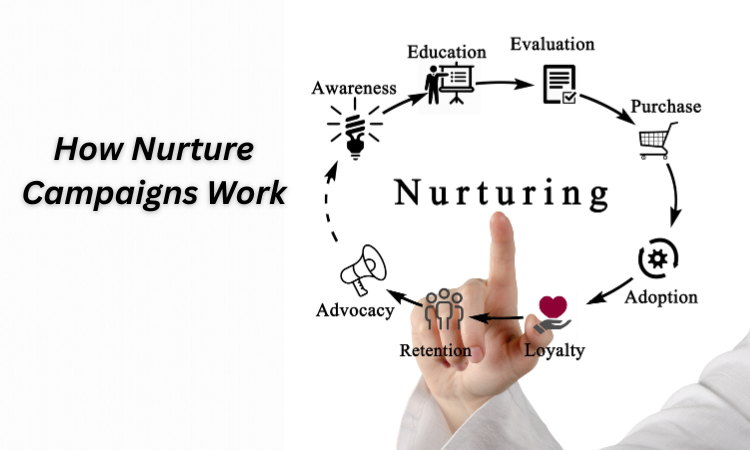Strong communication is the key to building lasting relationships in business.
Drip and nurture campaigns offer two different paths to connect with audiences, each with its own style.
Some campaigns move with steady timing like a set schedule, while others adjust naturally, responding to the audience’s actions.
Knowing how both work helps you choose the best fit for your goals. Each method brings its own pace, strategy, and impact.
In this article, you’ll explore what sets them apart and how to use them wisely, depending on the needs of your business.
Why are Drip Campaign and Nurture Campaign essential?
Drip and nurture campaigns are important tools for maintaining steady communication with potential customers.
Drip campaigns offer a structured flow of information, while nurture campaigns adjust content based on user behavior.
Using both helps businesses create a smooth and meaningful journey toward conversion.
What is a Drip Campaign?
Picture a steady stream of water dripping from a tap at regular intervals. A drip campaign follows a similar idea.
It involves sending a series of pre-written messages automatically over a set period. No matter how the recipient behaves, the sequence continues as planned.
Brands often use drip campaigns to educate users, remind them about their services, or move them through a basic learning curve.
These campaigns are straightforward and do not require real-time adjustments. They allow businesses to stay in touch with large groups without overwhelming their resources.
The predictability helps in maintaining communication without needing daily management.
Setting up a drip campaign is like planting seeds and watering them at regular intervals, hoping for steady growth.

What is a Nurture Campaign?
Sometimes communication needs to be more thoughtful. A nurture campaign acts like a garden that adjusts its care based on each plant’s needs.
Here, businesses design sequences that change depending on what the audience does.
If a person shows interest in a particular product, they receive information focused on that area.
If they ignore a message, the system adjusts to a softer approach or introduces different content.
A nurture campaign thrives on observation, patience, and personalization. It builds trust over time instead of pushing immediate action.
Instead of following a strict timeline, nurture campaigns respond to behavior, interests, and engagement patterns, creating a feeling of personal attention. People feel listened to, not just talked at.
Key Differences Between Drip and Nurture Campaigns
Though both drip and nurture campaigns aim to guide audiences, their methods are very different.
A drip campaign follows a preset route, ignoring how the audience reacts. It values consistency above all.
On the other hand, a nurture campaign listens and adapts, offering different messages based on the user’s interest level and actions.
Another big difference lies in timing. Drip campaigns stick to the clock, while nurture campaigns wait for the right signal.
Also, the level of personalization varies. Drip messages feel uniform and scheduled. Nurture messages feel personalized and reactive.
Understanding these differences matters because each campaign type supports different goals and audience behaviors.

Purpose and Goals of Drip Campaigns
Clarity and consistency define the purpose of a drip campaign. Businesses use drip campaigns when they want to deliver a structured series of messages without depending on audience feedback.
New customer onboarding, limited-time promotions, and educational sequences often follow this model.
A drip campaign keeps the audience moving through a path, if they engage deeply or not.
It aims to keep communication alive even if the interaction remains low. Drip campaigns also help maintain awareness.
They work well when businesses want a regular presence in the audience’s inbox, creating small reminders without needing constant adjustments.
The overall goal is to create a steady presence through minimal ongoing effort.
Purpose and Goals of Nurture Campaigns
Building relationships requires understanding and adapting. A nurture campaign focuses on meeting those needs.
Its main goal is to create trust, educate the audience, and gently guide them toward taking action based on their readiness.
Instead of pushing everyone through the same process, nurture campaigns allow people to move at their own pace.
Some users might be ready after two interactions. Others might need a lot more time and information.
Through personalization and responsiveness, nurture campaigns aim to feel less like marketing and more like assistance.
They help audiences feel supported, which often leads to deeper loyalty and higher conversions over time.

How Drip Campaigns Work
Setting up a drip campaign feels like creating a detailed travel itinerary. Every stop, every message, and every timeline is pre-decided.
You start by designing a clear sequence of communications. Maybe the first email welcomes the user.
Three days later, a second email highlights features. After a week, the third email highlights a story where a customer achieved great results.
No matter how the recipient interacts ,opening, ignoring, clicking ,the journey continues as planned.
Once launched, drip campaigns need very little maintenance, apart from occasional updates. Automation tools handle the scheduling, while businesses monitor overall performance.
The beauty of drip campaigns lies in their simplicity and structure, offering a reliable way to keep the audience engaged without continuous manual effort.
How Nurture Campaigns Work
Building a nurture campaign is like preparing for a conversation where you listen more than you speak.
It begins with an initial point of contact ,maybe someone downloads an ebook or fills out a form.
From there, the campaign watches closely. Did the person open the email? Did they click a link about pricing? Based on these actions, the next step is decided.
Perhaps one person receives more educational material, while another is invited to a live demo.
A nurture campaign works best when it stays flexible and responsive. Messages feel timely and relevant because they respond to user behavior, not a pre-fixed schedule.
Instead of moving everyone down the same path, nurture campaigns offer multiple personalized paths, depending on each individual’s needs and interests.

Timing and Triggers in Drip vs Nurture Campaigns
Consistency defines timing in drip campaigns. Messages are sent at pre-decided intervals no matter what the user does.
It could be after two days, then four days, then a week. Triggers are simple ,usually a form submission or a signup starts the process.
In contrast, nurture campaigns act like attentive hosts at a gathering. They wait for signals before making the next move.
Triggers could be a user opening an email, visiting a product page, or downloading a guide. Timing becomes dynamic rather than fixed.
This flexible timing feels more natural to users, creating stronger engagement because they receive the right information at the right moment, not just because a calendar says so.
Content Strategy for Drip Campaigns
Planning content for a drip campaign feels similar to outlining chapters in a book. Each email or message should build logically on the one before it.
You might start by introducing your service, then follow up with benefits, then share a client success story, and finally, push a soft call to action.
Since the sequence is fixed, messages must stand strong independently and as part of the whole series.
The tone remains generally informative and promotional but should avoid being too aggressive.
You want the reader to feel guided, not pressured. Visual consistency, clear calls to action, and straightforward messaging work best in drip sequences.
Content Strategy for Nurture Campaigns
Creating content for a nurture campaign demands a flexible, user-centered approach. Unlike drip content, nurture content adapts based on behavior.
If a person shows deep interest in product features, they should receive detailed how-to guides or webinars.
If someone seems hesitant, lighter educational materials, like blog posts or infographics, work better.
Content must be segmented carefully based on the user’s stage in the buying journey. Offering value becomes the central focus.
Pushy sales messages rarely succeed here. Instead, nurture content should educate, inspire, and address doubts at the right time.
Crafting helpful, timely content encourages natural movement toward decision-making without force.

When to Choose a Drip Campaign
Simple products or services with clear paths often pair well with drip campaigns.
If you have a straightforward goal ,like onboarding new users, reminding customers about an upcoming event, or promoting a free trial ,drip sequences provide structure without added complexity.
Setting up once and letting automation do the work saves time and keeps communication active.
Drip campaigns work beautifully for newsletters, short training series, or product updates.
When you expect most of your audience to have similar needs and move at a similar pace, choosing a drip approach makes more sense than building a complex, behavior-driven system.
When to Choose a Nurture Campaign
Situations that involve long decision cycles, high-value products, or skeptical audiences need a different touch.
Nurture campaigns shine where careful relationship-building matters more than quick wins.
For instance, if you offer business consulting services or high-end software solutions, the buying process could stretch across weeks or even months.
Prospects need education, reassurance, and personalized attention during this time.Nurture campaigns allow you to offer different paths depending on interest levels.
Some users might engage quickly after a couple of touchpoints; others may need multiple conversations and deeper content.
Flexibility, patience, and responsiveness make nurture campaigns ideal in these situations.
Common Mistakes in Drip and Nurture Campaigns
Launching a drip campaign and forgetting to update it is a timeless mistake. Businesses sometimes create a sequence and leave it running for years without reviewing content.
Messages become outdated or irrelevant, damaging trust. One frequent mistake in nurture campaigns is making the process too complicated.
Too many branches, too many options, and users get lost instead of guided. Simplicity often wins.
Clear pathways, regular reviews, and an audience-first mindset keep both campaign types healthy.
Forgetting to monitor engagement metrics also leads to missed opportunities. Regularly checking how users interact helps fine-tune content and timing, creating better results without needing complete overhauls.

Measuring the Success of Your Campaigns
Good campaigns tell their story through numbers. Open rates show if your subject lines attract attention.
Click rates reveal if your content sparks interest. Conversion rates tell the final part of the story ,did your audience act?
In drip campaigns, you look for consistent performance across the sequence. In nurture campaigns, you study behavior patterns and time gaps between actions.
High engagement and shorter decision times indicate success. Metrics like time-on-page, bounce rates, and downloads also provide valuable clues.
Success measurement is less about finding one magic number and more about understanding the full journey your users take.
Examples of Effective Drip Campaigns
An online learning platform might set up a drip campaign for new subscribers.
The first email welcomes them warmly, the second introduces featured courses, the third shares a success story from a past student, and the fourth offers a limited-time discount.
Each email is sent three days apart, keeping a regular rhythm. Because the messages are planned carefully, users feel guided instead of overwhelmed.
Another example could be an ecommerce site sending a drip series after someone abandons a cart ,first a gentle reminder, then a small incentive, and finally a “last chance” notice.
Drip campaigns work best when the timing and message flow feels natural.
Examples of Successful Nurture Campaigns
A company selling business software might use a nurture campaign that starts when someone downloads a free industry report.
If the person reads the report and explores pricing pages, they receive a demo invitation.
If they only read the report without further action, they get follow-up emails sharing best practices and success stories.
Over time, the system adapts, offering more specific case studies or free consultation offers based on each user’s level of interest.
Another example is a fitness brand offering personalized workout plans based on user responses, nurturing the relationship until the user subscribes. Success here comes from responsiveness and relevance.
Best Practices for Drip and Nurture Campaigns
Starting with clear goals makes every campaign stronger. Before writing a single email, know what action you want the audience to take.
Maintain a friendly and helpful tone across communications. Personalization improves performance even in simple drip sequences ,using names, mentioning specific actions, or tailoring content slightly can lift engagement rates.
Always segment your audience wisely. Not every user needs the same message.
Testing subject lines, email content, and send times through A/B testing offers valuable insights.
Regularly updating and assessing your content helps keep your campaigns fresh, engaging, and aligned with your audience’s needs.

How Brandout Optimizes Drip Campaign and Nurture Campaign?
Brandout improves drip and nurture campaigns through smart planning and digital marketing services.
For drip campaigns, it sends messages at the right times to guide users step by step.
For nurture campaigns, Brandout personalizes content based on what users do, making them more engaged.
With a mix of automation and personal touch, Brandout helps businesses run campaigns that connect better with their audience.
Final Thoughts:
Choosing the right campaign style depends on understanding your ideal audience and specific goal.
If you want a structured, low maintenance way to guide users through a short journey, a drip campaign provides the right solution.
If your audience needs more education, reassurance, and personalized attention, nurturing offers a better path.
Both drip and nurture campaigns have important roles in marketing strategies.
Thoughtful planning, careful listening, and regular optimization turn these campaigns from ordinary email sequences into powerful relationship builders.
In the end, it is not about choosing the trendiest method ,it is about meeting your audience’s needs in the best way possible.
Answer to your questions:
What is the difference between drip and nurture campaigns?
A drip campaign sends pre-scheduled messages at fixed times, no matter how users react.
A nurture campaign changes messages based on user behavior, offering a more personal experience.
Drip campaigns focus on consistency, while nurture campaigns focus on relationships. Both help businesses stay connected but in different ways.
What is a nurture campaign?
A nurture campaign is a series of personalized messages designed to build trust with the audience over time.
Messages adjust based on user actions, interests, and engagement.
Instead of following a fixed schedule, nurture campaigns respond to what users do. They help guide people naturally toward a decision.
What is a drip campaign?
A drip campaign is a sequence of automated messages sent at scheduled intervals.
It does not change based on the user’s behavior. Businesses often use drip campaigns to educate, welcome, or remind their audience.
Once set up, they run automatically and keep communication steady.
What is a drip campaign example?
Imagine an online store sending a welcome email after signup, then a discount offer three days later, and a reminder about new arrivals a week later.
These emails go out on a set timeline, no matter how the user responds. This is a classic example of a drip campaign.




